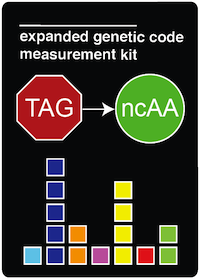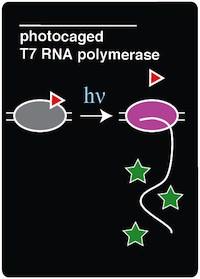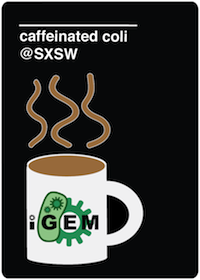Team:Austin Texas
From 2014.igem.org
Jordanmonk (Talk | contribs) m |
|||
| Line 79: | Line 79: | ||
<h1>Project: Expanded Genetic Code Measurement Kit</h1> | <h1>Project: Expanded Genetic Code Measurement Kit</h1> | ||
| - | Noncanonical amino acids (ncAAs) are an exciting new tool in the biological researchers toolbox. Incorporating ncAAs into proteins will allow scientists to create bacteria that can perform novel or new functions. The amberless E. coli used in this kit have had all the amber stop codons in its genome recoded and removed to allow the amber codon to be used for ncAAs. Unfortunately, these noncanonical amino acids are often difficult to incorporate into proteins due to a low fidelity of the synthetase/tRNA pair. Our project aims to create a kit that can measure the fidelity of the synthetase/tRNA pair and incorporation of several different noncanonical amino acids into fluorescent proteins. The kit is a simple two-plasmid system. The first plasmid contains an IPTG-inducible RFP, followed by a linker sequence containing a recoded amber stop codon (where the ncAA will be incorporated) and sfGFP. The other plasmid contains the synthetase/tRNA pair. When the RFP-linker-GFP protein is induced and exposed to the excitation wavelengths for RFP and GFP, the fluorescence of both parts of the fusion protein can be measured and compared. Depending on the relative intensities of the RFP and GFP fluorescent proteins, we can determine how efficient the synthetase/tRNA pairs are at incorporating the ncAA. We plan to equip researchers with a quick and easy “plug and play” system that contains easily interchangeable parts. Researchers will be able to insert any plasmid containing a new synthetase/tRNA pair into our pre-made cells to test the fidelity and incorporation of various ncAAs. | + | Noncanonical amino acids (ncAAs) are an exciting new tool in the biological researchers toolbox. Incorporating ncAAs into proteins will allow scientists to create bacteria that can perform novel or new functions. The amberless <i>E. coli</i> used in this kit have had all the amber stop codons in its genome recoded and removed to allow the amber codon to be used for ncAAs. Unfortunately, these noncanonical amino acids are often difficult to incorporate into proteins due to a low fidelity of the synthetase/tRNA pair. Our project aims to create a kit that can measure the fidelity of the synthetase/tRNA pair and incorporation of several different noncanonical amino acids into fluorescent proteins. The kit is a simple two-plasmid system. The first plasmid contains an IPTG-inducible RFP, followed by a linker sequence containing a recoded amber stop codon (where the ncAA will be incorporated) and sfGFP. The other plasmid contains the synthetase/tRNA pair. When the RFP-linker-GFP protein is induced and exposed to the excitation wavelengths for RFP and GFP, the fluorescence of both parts of the fusion protein can be measured and compared. Depending on the relative intensities of the RFP and GFP fluorescent proteins, we can determine how efficient the synthetase/tRNA pairs are at incorporating the ncAA. We plan to equip researchers with a quick and easy “plug and play” system that contains easily interchangeable parts. Researchers will be able to insert any plasmid containing a new synthetase/tRNA pair into our pre-made cells to test the fidelity and incorporation of various ncAAs. |
|- valign="top" | |- valign="top" | ||
| [[Image:Austin_Texas_Photocage_Card.png|link=Team:Austin_Texas/photocage]] | | [[Image:Austin_Texas_Photocage_Card.png|link=Team:Austin_Texas/photocage]] | ||
| Line 92: | Line 92: | ||
| [[file:caffeinecolisxsw.png|200px| link=https://2014.igem.org/Team:Austin_Texas/human_practices]] | | [[file:caffeinecolisxsw.png|200px| link=https://2014.igem.org/Team:Austin_Texas/human_practices]] | ||
|<h1>Human Practices: Caffeinated Coli @ SXSW Create</h1> | |<h1>Human Practices: Caffeinated Coli @ SXSW Create</h1> | ||
| - | In the spring of 2014, the UT iGEM team was invited to create a booth at the [http://sxsw.com/exhibitions/sxsw-create/participants-2014 SXSW Interactive Create Event.] Team members took the opportunity to educate the public on the applications and potential benefits of genetically modified organisms. In a concerted effort between past and present team members, the group banded together for the first time to create an informative, and fun presentation relating to the previous iGEM 2012 team project, the [https://2012.igem.org/Team:Austin_Texas/Caffeinated_coli| ''Caffeinated | + | In the spring of 2014, the UT iGEM team was invited to create a booth at the [http://sxsw.com/exhibitions/sxsw-create/participants-2014 SXSW Interactive Create Event.] Team members took the opportunity to educate the public on the applications and potential benefits of genetically modified organisms. In a concerted effort between past and present team members, the group banded together for the first time to create an informative, and fun presentation relating to the previous iGEM 2012 team project, the [https://2012.igem.org/Team:Austin_Texas/Caffeinated_coli| ''Caffeinated Coli.''] Our new project though went further, using caffeinated coli to calculate the amount of caffeine found in coffee, an organic beverage that is not formulaic. This allowed us to reach out to the wider Austin community and talk with them about science and synthetic biology. |
|} | |} | ||
Revision as of 07:03, 17 October 2014
| |||||||||||||||||||||||||||||||||||
 "
"




